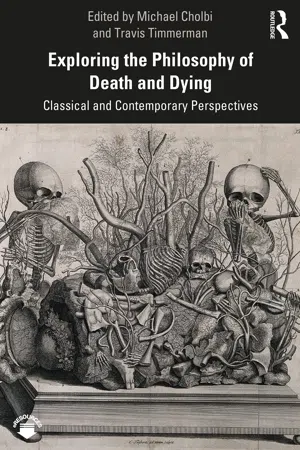
Exploring the Philosophy of Death and Dying
Classical and Contemporary Perspectives
- 272 pages
- English
- ePUB (mobile friendly)
- Available on iOS & Android
Exploring the Philosophy of Death and Dying
Classical and Contemporary Perspectives
About this book
Exploring the Philosophy of Death and Dying: Classical and Contemporary Perspectives is the first book to offer students the full breadth of philosophical issues that are raised by the end of life. Included are many of the essential voices that have contributed to the philosophy of death and dying throughout history and in contemporary research. The 38 chapters in its nine sections contain classic texts (by authors such as Epicurus, Hume, Nietzsche, and Schopenhauer) and new short argumentative essays, specially commissioned for this volume, by world-leading contemporary experts.
Exploring the Philosophy of Death and Dying introduces students to both theoretical issues (whether we can survive death, whether death is truly bad for us, whether immortality would be desirable, etc.) and urgent practical issues (the ethics of suicide, the value of grief, the appropriate medical criteria for declaring death, etc.) raised by human mortality, enabling instructors to adapt it to a wide array of institutions and student audiences.
As a pedagogical benefit, PowerPoints, discussion questions, and test questions for each chapter are included as online ancillary materials.
Frequently asked questions
- Essential is ideal for learners and professionals who enjoy exploring a wide range of subjects. Access the Essential Library with 800,000+ trusted titles and best-sellers across business, personal growth, and the humanities. Includes unlimited reading time and Standard Read Aloud voice.
- Complete: Perfect for advanced learners and researchers needing full, unrestricted access. Unlock 1.4M+ books across hundreds of subjects, including academic and specialized titles. The Complete Plan also includes advanced features like Premium Read Aloud and Research Assistant.
Please note we cannot support devices running on iOS 13 and Android 7 or earlier. Learn more about using the app.
Information
Part IWhen Do We Die?
A Death-Scene
Introduction to Part I
When Do We Die?
- Michael Nair-Collins, Sydney R. Green, and Angelina R. Sutin’s “Abandoning the Dead Donor Rule? A National Survey of Public Views on Death and Organ Donation” (2015) Journal of Medical Ethics 41 (4):297–302.
- Cody Gilmore’s “When Do Things Die?” in The Oxford Handbook of Philosophy of Death (2013) edited by Ben Bradley, Fred Feldman, and Jens Johansson, New York: Oxford University Press.
- Fred Feldman’s book Confrontations with the Reaper: A Philosophical Study of the Nature and Value of Death (1992) New York: Oxford University Press.
- Peter Singer’s book Rethinking Li...
Table of contents
- Cover
- Half Title
- Title Page
- Copyright Page
- Table of Contents
- List of Contributors
- Acknowledgements
- Introduction
- Part I: When Do We Die?
- Part II: Can We Survive Our Death?
- Part III: Can Death Be Good or Bad for Us? If So, When Is It Good or Bad for Us?
- Part IV: Can Lucretius’ Asymmetry Problem Be Solved?
- Part V: Would Immortality Be Good for Us?
- Part VI: What Is the Best Attitude to Take Toward Our Mortality?
- Part VII: How Should We React to the Deaths of Others?
- Part VIII: Is Suicide Rationally or Morally Defensible?
- Part IX: How Does Death Affect the Meaningfulness of Our Lives?
- Index